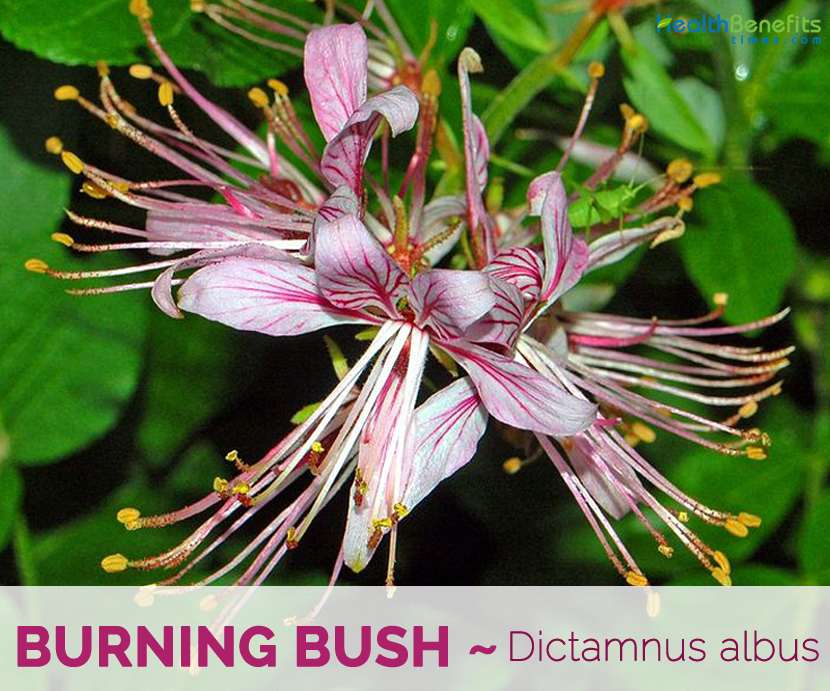| Burning Bush Quick Facts | |
|---|---|
| Name: | Burning Bush |
| Scientific Name: | Dictamnus albus |
| Origin | Southern Europe, north Africa and much of Asia |
| Shapes | Fruit capsule containing four red-orange seeds |
| Taste | Bitter and unpalatable taste |
| Health benefits | Lowers fevers and controls bacterial and fungal infections, Cures scabies and eczema, german measles, arthritic pain and jaundice |
Plant Description
Burning bush is a fast-growing, herbaceous perennial shrub that grows about 61–122 cm (2–4 feet) in height. The plant easily grows in average, medium, well-drained soils. Normally it prefers evenly moist, fertile, humusy soils that do not become soggy. The plant has long, deep tap root. Numerous erect, unbranched and sticky-glandular haired shoots grow from the root. Its green stems usually have prominent, corky wings.
Leaves
Elegant, glossy, odd-pinnate, light green leaves are attractive throughout the growing season and release a pleasant lemony fragrance when rubbed or crushed. Foliage also contains oil that causes allergic reactions (skin rash) in some individuals. The leaves turn a brilliant purplish-red to scarlet in the fall.
Flower and Fruit
The flowers are terminal racemes and pink with dark veins. They are large and irregular, with 5 sepals and 5 petals. There are 2 bracteoles that are slightly zygomorphous. The 10 stamens are long, threadlike and bent forward. The ovaries have 5 carpels fused at the base on a short gynophore. Flowers give way to star-shaped seed heads which provide some ornamental interest if left on the plant. Fruit capsule bursts open into mericarps ejecting to expose four red-orange seeds. In hot weather, old flowers or seed pods emit a flammable oil which, on a windless summer evening, can be ignited with a match resulting in a brief vapor burn which is harmless to the plant, hence the common name.
More varieties for Gas plant
Purple gas plant
Dictamnus albus ‘Purpureus’ has purplish-pink flowers with dark veins and stems. As with all forms of gas plant, it is slow to establish.
White gas plant
Dictamnus albus ‘Albiflorus’ has white flower spikes that develop into star-shape nut-brown seed pods in fall.
https://www.youtube.com/watch?v=LucVEJSz3bA
Traditional uses and benefits of Burning Bush
- Powder is combined with that of peppermint for use in epilepsy.
- Root bark lowers fevers and controls bacterial and fungal infections.
- It strongly stimulates the muscles of the uterus, inducing menstruation and sometimes causing abortion.
- They are abortifacient, anthelmintic, antispasmodic, aromatic, digestive, diuretic, emenagogue, expectorant, febrifuge, galactogogue, stimulant and tonic.
- Plant is used both internally and externally in the treatment of skin diseases (especially scabies and eczema), German measles, arthritic pain and jaundice.
- It is little used in Western herbalism nowadays, though it has been recommended for use in nervous complaints, intermittent fevers, scrofulous and scorbutic diseases.
- An infusion of the leaves is used as a tea substitute and is a good digestive.
- Homeopathic remedy is made from the fresh leaves is used in the treatment of female complaints and constipation.
- It lowers fever and controls bacterial and fungal infections.
- It induces Menstruation and stimulates muscles of uterus.
- To cure kidney stones soak one tbsp rootstock of white dittany in one cup of water overnight. Take a mouthful at a time. One cup a day.
- Root bark is a bitter, strong-smelling herb that lowers fevers and controls bacterial and fungal infections.
- Both the flowering stems and the root-bark are used medicinally.
- At Europe, Burning Bush Root is suggested in folk medicine for treat stomach disorders, cramps and worm infestation, and to promote menstruation.
- Burning Bush root is used for amenorrhea and the regulation of labor in India.
- It is used as a tonic and a stimulant in Greece.
- Burning Bush root is used for jaundice, inflammation of the skin, rheumatic ailments, fever, and hemorrhage of the womb, thread fungus, as a sedative, tonic and for nervous crying in children.
- It is also found in decoctions for the external treatment of eczema, impetigo and scabies.
- It served as a urinary aid and was used in the treatment of epilepsy, in combination with mistletoe and peony.
- At the end of the 19th century, the drug was applied as an ointment for rheumatism.
Other Facts
- The plant has a strong lemon or cinnamon fragrance.
- Whole plant, when rubbed, gives out an odor like lemon-peel.
- Burning bush has been used in Chinese herbal medicine for at least 1,500 year.
- It is called “gas plant” because its leaves emit a volatile oil that is actually flammable!
- Its lemon scented leaves help control mosquitos.
Precautions
- All parts of the plant may cause mild stomach upset if eaten, and contact with the foliage may cause photo dermatitis.
- High doses may lead to photo toxicity.
- Handling the plant may cause an allergic reaction.
- Avoid if you are pregnant, it may cause abortion.
References:
https://www.itis.gov/servlet/SingleRpt/SingleRpt?search_topic=TSN&search_value=502054#null
https://davesgarden.com/guides/pf/go/17/
https://npgsweb.ars-grin.gov/gringlobal/taxonomydetail.aspx?id=13928
http://www.missouribotanicalgarden.org/PlantFinder/PlantFinderDetails.aspx?kempercode=c490
http://www.floracatalana.net/dictamnus-albus-l-
https://www.botanical.com/botanical/mgmh/b/burbus91.html
http://www.theplantlist.org/tpl/record/kew-2766952
https://plants.usda.gov/core/profile?symbol=DIAL4
http://www.docs.dcnr.pa.gov/cs/groups/public/documents/document/dcnr_010293.pdf
https://pfaf.org/user/Plant.aspx?LatinName=Dictamnus+albus
https://en.wikipedia.org/wiki/Dictamnus
Comments
comments
